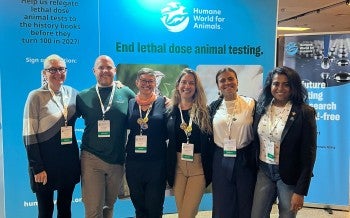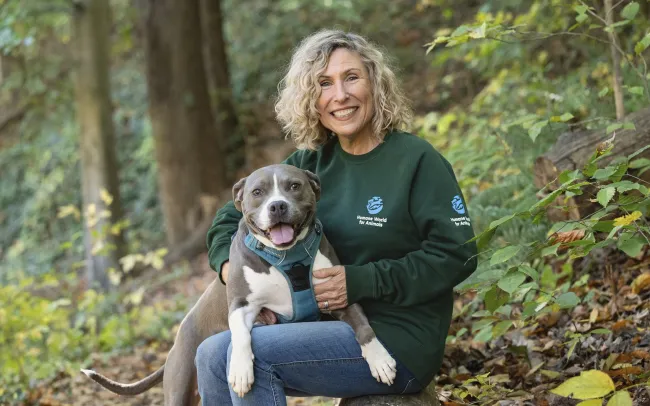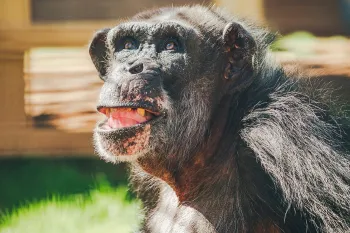In lethal dose tests, animals are forced to swallow, inhale or absorb through their skin a massive dose of a chemical or product until most are dying or dead. Those who survive are killed. It is hard to imagine or quantify their suffering. Put simply, lethal dose tests are as horrific as they sound, and are a living nightmare for the countless rats, mice, birds, fish and other animals used as test subjects.
In our age, one so characterized by astonishing advances in technology, it is nothing less than absurd that a test like this survives at all, much less that governing bodies expressly require it for product approvals. The original lethal dose test was invented in 1927, nearly a century ago. For context, this was the same year Ford came out with the Model A car, and the same year that the first movie with sound came out in theatres. While changes to these tests have been made since then, including reduction in number of animals used, lethal dose tests still involve severe animal suffering and death.
While some industries have evolved dramatically with the pace of technology, government health and environmental safety regulations are still heavily based on animal testing despite the growing availability and capability of non-animal methods. Many countries still require the lethal dose test for chemical, pesticide and pharmaceutical product approval, even in cases where advanced computer and cell-based replacements for lethal dose tests are available; such tests not only remove the need to kill animals but are just as reliable in ensuring products are safe for humans and the environment.
We’re working across the globe to end a century of cruelty, by consigning lethal dose tests to the history books and working in key nations to advance the progress of safe, animal-free science.
In Europe, a moment of real transformation is at hand. The EU’s chemical regulation is being revised for the first time in almost twenty years, and policymakers have a golden opportunity to end the use of lethal dose tests and embrace the use of modern, non-animal replacements.
In October, we hosted a European Parliament roundtable in Brussels that bought together policymakers, regulators, industry, academics, environmental groups and other interested parties to chart a path forward. Parliamentarian Niels Fuglsang called the revision of the regulations a “historic opportunity… to embed cutting-edge non-animal methods into the heart of our regulatory system, and to uphold our commitments to both scientific progress and animal welfare,” while parliamentarian Tilly Metz gave voice to the 1.2 million+ citizens who signed our European Citizens’ Initiative, demanding “a clear and measurable timeline to phase out animal testing, and full transparency in how safety decisions are made. Protecting human health and the environment must go hand in hand with protecting animals.”
Industries and regulators must have the practical tools to make the transition to animal-free science. As convenors of the Animal-Free Safety Assessment Collaboration, we hosted a workshop in Scotland in April, bringing together scientific and thought leaders representing industry, method developers and academia, to design resources that support the use of non-animal methods in safety science. Currently, our team is developing an interactive tool to help industry and regulators decide where animal-free methods can be used instead of lethal dose tests.
In August, we launched a global campaign to end lethal dose testing at the 13th World Congress on Alternatives and Animal Use in the Life Sciences 2025 in Rio de Janeiro. In Brazil, our team is currently working with the National Commission on Chemical Safety to finalize new regulations that will help limit animal testing, and to create a national plan to expand the use of animal-free methods.
In Canada, our team worked closely with Health Canada and Environment and Climate Change Canada to help develop a strategy to replace, reduce or refine vertebrate animal testing. As part of our continued efforts, we are convening a multistakeholder workshop this November during the Canadian Science Policy Conference 2025 to address the challenges and opportunities surrounding the implementation of this strategy, including the immediate opportunity to phase-out lethal dose tests for chemicals and pesticides.
Meanwhile, in South Korea, we’re urging the Ministry of Climate, Energy, and the Environment to remove lethal dose testing requirements for chemicals as a concrete step in its commitment for 60% of chemical assessments to use alternative methods by 2030.
Even though India does not currently have a policy that prescribes lethal dose animal tests for chemicals, our research shows that they are still widely used, and we are beginning our efforts to help phase them out.
In the U.S., as a part of our efforts to advance the U.S. government’s commitments to end animal experiments, we co-authored a scientific publication with government agencies that demonstrates how a computer model (known as CATMoS) can replace a lethal animal test that is currently required for pesticides. If officially adopted by the Environmental Protection Agency, rats will be spared from being force-fed pesticides in many cases. If the EPA embraces CATMoS for pesticides, this will provide a regulatory precedent that can be used by our teams who are in similar dialogue with pesticide regulators in other countries.
We are at the threshold of ending one of the most objectionable scientific procedures in the history of animal use. Join us by signing our petition to urge decision makers to finally end lethal dose animal tests. Let’s ensure that a century of cruelty makes way for a century of compassion, or more, and with it, a safer, kinder future for humans and animals alike.
Kitty Block is president and CEO of Humane World for Animals. Follow Kitty Block on X. Sara Amundson is president of Humane World Action Fund.





